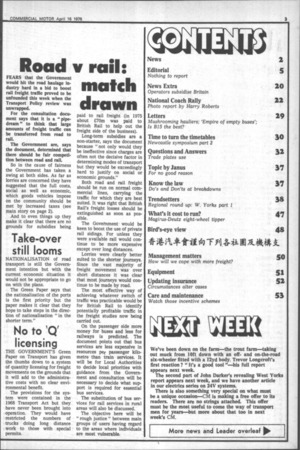Road v rail: match drawn
Page 5

If you've noticed an error in this article please click here to report it so we can fix it.
FEARS that the Government would hit the road haulage industry hard in a bid to boost rail freight traffic proved to be unfounded this week when the Transport Policy review was unwrapped.
For the consultation document says that it is a " pipedream " to think that large amounts of freight traffic can be transferred from road to rail.
The Government are, says the document, determined that there should be fair competition between road and rail.
So in the cause of fairness the Government has taken a swing at both sides. As far as lorries are concerned they have suggested that the full costs, social as well as economic, which goods vehicles impose on the community should be met by increased taxes (see main story on page 2).
And to even things up they make it clear that there are no grounds for subsidies being paid to rail freight (in 1975 about £70m was paid to British Rail to help out the freight side of the business).
Long-term subsidies are a non-starter, says the document because "not only would they be ineffective since charges are often not the decisive factor in determining modes of transport but they would be exceedingly hard to justify on social or economic grounds."
Both road and rail freight should be run on normal commercial lines, carrying the traffic for which they are best suited. It was right that British Rail's freight losses should be extinguished as soon as possible.
The Government would be keen to boost the use of private rail sidings. For unless they were available rail would continue to be more expensive except over long distances.
Lorries were clearly better suited to the shorter journeys. Since the vast majority of freight movement was over short distances it was clear that most journeys would continue to be made by road.
The most effective way of achieving whatever switch of traffic was practicable would be for British Rail to identify potentially profitable traffic in the freight studies now being carried out.
On the passenger side more money for buses and less for railways is predicted. The document points out that bus services are less expensive in resources per passenger kilometre than train services. It will be for Local Authorities to decide local priorities with guidance from the Government and consultation will be necessary to decide what support is required for essential bus services.
The substitution of bus services for rail services in rural areas will also be discussed.
The objective here will be "rough justice" between main groups of users having regard to the areas where individuals are most vulnerable.




























































































